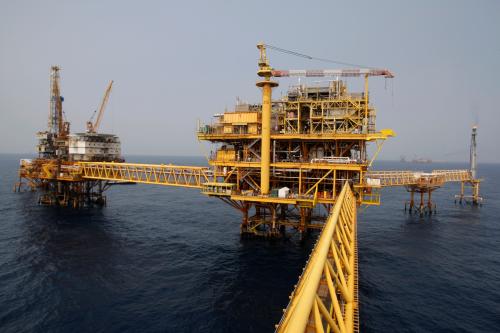Crude oil prices have dropped over 20 percent the past two weeks, reminding observers of just how uncertain the oil market has become. That uncertainty started in 1973 when the OPEC cartel first drove prices sharply higher by constraining production. During the 1980s and 90s, new offshore oil fields kept non-OPEC supplies growing and moderated price movements. But as these supplies declined, price volatility has been greater than ever.
Crude oil prices soared from $20 per barrel (WTI) in the 2001 recession to a brief peak of $140 early in 2008. Prices dropped back to $40 in the Great Recession and rose back to $120 in 2014 as the economy recovered. And then the cyclical pattern was broken. Oil prices collapsed again, but not because the economy was heading back into recession, but because of the steady rise of oil from shale fields—a dominant new source of oil supply in the world.
The growth in supply from shale temporarily stalled when prices crashed in 2014. Its renewed growth was one big factor leading to the present oil price decline. Other factors were more transitory and chaotic. President Trump’s insistence that he would shut Iran out of the world oil market led to expectations of reduced global supplies and higher prices. It also led the Saudis and Russians to expand output to fill the expected void. So production from the world’s three largest producers rose sharply. And then Trump announced he would not restrict buying from Iran after all. In this environment, the OPEC cartel and the Russians met this past weekend to discuss plans for production targets in 2019, and reportedly agreed to cut production in order to support oil prices. President Trump responded “Hopefully Saudi Arabia and OPEC will not be cutting oil production. Oil prices should be much lower based on supply”.
Is Trump likely to get his wish? On the demand side of the oil market, the growing prosperity in China and the rest of Asia is expanding car markets and the demand for gasoline. This process is likely to continue for decades. On the other hand, car markets in the advanced economies are moving toward hybrids and all-electric cars. Defense, shipping and airline demands for fuel continue to grow as in the past. How this will balance out is hard to quantify. But global demand projections are surely being marked down from those made 5 years ago.
On the supply side, shale is now firmly established and in the hands of the big oil companies. Production will expand to new areas and will be the main source of growth in global oil supplies. Case-in-point: U.S. shale output is expected to reach record highs in December 2018. When rising shale output created great oversupply and crashed the oil price in 2014 to below $40, the less productive shale fields shut down. Current output is centered on more productive fields, so more output would be sustained at $40 today. And unlike conventional oil fields, whose production declines gradually regardless of what happens to price, shale production is price sensitive—so prices should be less volatile as well as lower.
Shale oil has not been around for long. But it has been a wild period from which we can infer a couple of things about the likely future. The business cycle will still cause cyclical oil price movements. But unless the potential supply of shale oil is much smaller than now seems likely, the average price of oil looking forward should be low relative to the experience since 2000. Big shocks to supply will still lead to price spikes and extended disruptions of supply will still produce extended high prices. But absent such shocks, reasonable judgments about future supplies and demands on the global market suggest the next 20 years will average noticeably lower prices than the past 20. Trump will get his wish. And OPEC cannot do enough to change that prospect.





Commentary
Oil prices are tumbling. Volatility aside, expect them to stay low over the next 20 years.
November 14, 2018
George Perry explains why oil prices will likely stay lower for the forseeable future.